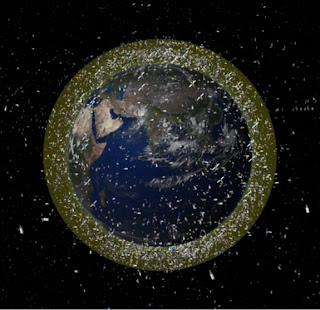
The news that a failed Russian Mars probe will come crashing back to Earth in the next few days reinforces a growing public perception that the sky is falling — that huge pieces of space junk could rain down on us at any moment.
Russian officials estimate that the 14.5-ton Phobos-Grunt spacecraft, which became stuck in Earth orbit shortly after its Nov. 8 launch, will re-enter the atmosphere sometime between Saturday and Monday (Jan. 14 to Jan. 16). It will be the third uncontrolled satellite re-entry in four months, following NASA's defunct UARS craft in September and the dead German ROSAT satellite in October.
These high-profile events have helped put space junk on the map for many people who had never worried about the possibility, however remote, of getting conked on the head by a satellite shard. For example, insurance giant State Farm saw fit to address the issue just ahead of the UARS crash.
"While claims are handled on a case-by-case basis, you might be surprised to learn damage from satellite debris, aka space junk, likely would be covered under most insurance policies," the company wrote in a blog post Sept. 22, just two days before UARS came down. [6 Biggest Spacecraft to Fall Uncontrolled From Space]
Another major company, Farmers Insurance, aired a commercial during this winter's college football bowl games offering similar assurances to its current and potential customers.
And a new IMAX film called "Space Junk 3D" is felicitously timed to hit theaters Friday (Jan. 13). The movie aims to raise awareness of the threat that orbital debris poses to space exploration and satellite communications.
A huge cloud of debris
Since the dawn of the space age in 1957, humanity has managed to clutter up near-Earth space with a staggering amount of junk. Much of it is defunct satellites, old rocket bodies and the shrapnel spawned when these objects collide.
NASA estimates that our planet's orbital debris cloud contains more than 500,000 pieces larger than a marble and more than 20,000 at least as big as a softball. The United States' Space Surveillance Network is tracking the softball-size objects to try to prevent collisions.
Despite the fevered media response to dramatic events like the UARS crash, space junk poses little threat to people on the ground. Most pieces of falling satellites burn up the atmosphere, and the bits that make it through are likely to land harmlessly in the ocean or on uninhabited land. To date, nobody is known to have been injured by a chunk of falling debris.
But that's not to say space debris is innocuous. It poses a real threat to the craft that orbit and observe our planet and provide navigation and telecommunications services. In 2009, for example, the Iridium 33 communications satellite was destroyed when it slammed into a defunct Russian satellite.
And space junk can endanger astronauts circling Earth. In June 2011, the possibility of a collision between debris and the International Space Station forced the crew of the orbiting lab to take shelter in a docked Soyuz vehicle, in case they needed to make a speedy getaway. The debris did not end up hitting the station.
There's still time
Such incidents notwithstanding, Earth's debris cloud is not yet thick enough to seriously affect manned or robotic space operations, NASA officials say.
"It's really not too bad right now," said Nick Johnson, chief scientist of NASA's Orbital Debris Program Office at the Johnson Space Center in Houston. "We're not losing spacecraft right and left due to debris. But later in the century, the situation is going to be noticeably different if we don't do something different."
Johnson said humanity probably will have to come up with some effective ways to clean up the junk clogging Earth orbit. The good news is that we have time to figure something out, because the rate of debris accumulation is projected to remain quite low for decades to come.
"There is no urgency, thankfully. We can easily wait 10 or 15 years before we start doing anything," Johnson told SPACE.com. "We have time to go do this right." [Photos: Space Debris Images & Cleanup Concepts]
Taking the problem seriously
Another piece of good news, Johnson said, is that the orbital-debris threat, long recognized by those in the space community, has finally made it onto the radar of decision-makers in the United States and abroad.
Three events in recent years really brought the issue to the awareness of U.S. political and military leaders, according to Brian Weeden, a technical adviser with the Secure World Foundation and a former orbital analyst with the Air Force.
The first was a Chinese anti-satellite test in 2007, which added about 3,000 new pieces of space junk to the orbiting population. The second came in 2008, when the U.S. destroyed its malfunctioning spy satellite USA-193 in a manner that did not create a huge cloud of long-lasting debris. And the third was the Iridium 33 collision.
"It was those three things that kind of woke us up," Weeden told SPACE.com. The top brass have begun coming to grips with the fact that space is a busy and congested place, with many stakeholders around the world, he said.
"You have a situation where you have many people using something, and you have to figure out how you're going to use it in a sustainable manner for the long term," Weeden said. "And that's what everybody's working on right now."



0 komentar:
Post a Comment
Tolong tinggalkan komentar untuk kemajuan blog ini...
Tolong Laporkan Bila Ada link Download Yang Mati Atau Tidak Berfungsi..Terimakasih
Para pengurus Blog bayu7key Tidak selalu Online untuk memantau Komentar yang Masuk, Jadi tolong berikan Komentar Anda dengan Pantas dan Layak dikonsumsi oleh Publik. No SARA, SPAM dan Sejenisnya.